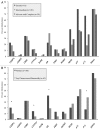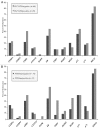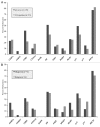Epigenetic differences in cytogenetically normal versus abnormal acute myeloid leukemia
- PMID: 20671427
- PMCID: PMC3052845
- DOI: 10.4161/epi.5.7.12558
Epigenetic differences in cytogenetically normal versus abnormal acute myeloid leukemia
Abstract
Background: Methylation of tumor suppression genes (TSGs) is common in myeloid malignancies. However, application of this as a molecular marker for risk stratification in patients with AML is limited.
Design and methods: To elucidate the impact of patterns of TSG methylation on outcome in cytogenetically normal patients, 106 samples from patients with having normal cytogenetic AML were evaluated for methylation of 12 genes by MSP. For sake of comparison, samples from patients with AML and abnormal cytogenetics (n = 63) were also evaluated.
Results: Methylation frequencies in the whole group (n = 169) were similar to previous reports for CDH1 (31%), ER (31%), FHIT (9%), p15 (INK4b) (44%), p73 (25%), and SOCS1 (75%). Methylation of CTNNA1 was observed in 10%, CEBP-α in16%, CEBP-δ in 2%, MLH1 in 24%, MGMT in 11% and DAPK in 2% of AML samples. We find that DNA methylation was more prevalent in patients with normal compared to karyotypically abnormal AML for most genes; CEBPα (20% vs 9%), CTNNA1 (14% vs 4%), and ER (41% vs 19%) (p < 0.05 for all comparisons). In contrast, p73 was more frequently methylated in patients with karyotypic abnormalities (17% vs 38%; p < 0.05), perhaps due to specific silencing of the pro-apoptotic promoter shifting p73 gene expression to the anti-apoptotic transcript. In AML patients with normal cytogenetics, TSG methylation was not associated with event free or overall survival in a multivariate analysis.
Conclusions: In patients with AML, TSG methylation is more frequent in patients with normal karyotype than those with karyotypic abnormalities but does not confer independent prognostic information for patients with normal cytogenetics.
Figures





References
-
- Estey E, Dohner H. Acute myeloid leukaemia. Lancet. 2006;368:1894–1907. - PubMed
-
- Jabbour EJ, Estey E, Kantarjian HM. Adult acute myeloid leukemia. Mayo Clin Proc. 2006;81:247–260. - PubMed
-
- Shimamoto T, Ohyashiki JH, Ohyashiki K. Methylation of p15(INK4b) and E-cadherin genes is independently correlated with poor prognosis in acute myeloid leukemia. Leuk Res. 2005;29:653–659. - PubMed
-
- Aggerholm A, Holm MS, Guldberg P, Olesen LH, Hokland P. Promoter hypermethylation of p15INK4B, HIC1, CDH1 and ER is frequent in myelodysplastic syndrome and predicts poor prognosis in early-stage patients. Eur J Haematol. 2006;76:23–32. - PubMed
Publication types
MeSH terms
Substances
Grants and funding
LinkOut - more resources
Full Text Sources
Medical
Research Materials
Miscellaneous
